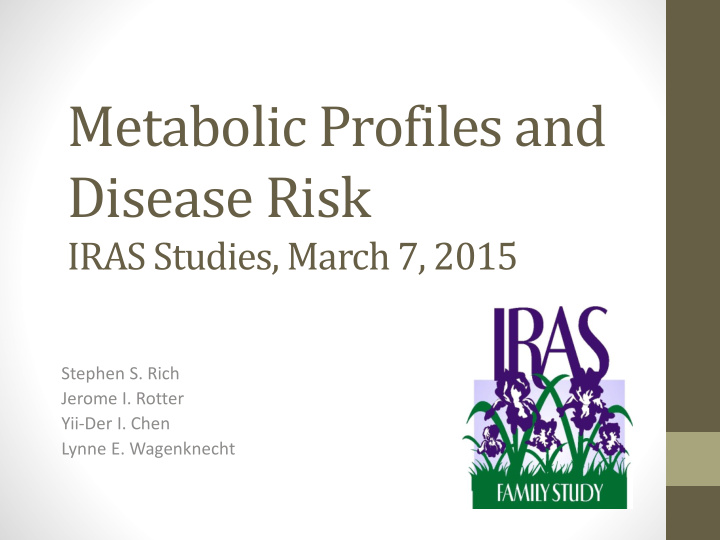



Metabolic Profiles and Disease Risk IRAS Studies, March 7, 2015 Stephen S. Rich Jerome I. Rotter Yii-Der I. Chen Lynne E. Wagenknecht
Study Goals IRAS (Classic): Examine the relationship between directly measured insulin sensitivity and carotid atherosclerosis, across the range of glycemic status and ethnicity. IRAS Family: Examine the genetic and environmental basis of insulin resistance and abdominal adiposity in a minority, family-based cohort Wagenknecht LE, et al. The Insulin Resistance Atherosclerosis Study (IRAS): Objectives, design and recruitment results. Ann Epidemiol 1995;5:464-472. Henkin L, et al. Genetic epidemiology of insulin resistance and visceral adiposity. The IRAS Family Study design and methods. Ann Epidemiol 2003;13(4):211-217.
Comparison of IRAS Studies IRAS (Classic) IRAS Family • Individuals, age 45-65 • Large families, age 18-81 • Hispanic/AA/White from 4 • Hispanic/AA from 3 regions regions • Selected for large families • Selected across range of from IRAS glycemic status • Primary phenotypes* • Primary phenotypes* include FSIGT & adiposity include FSIGT & carotid by CT scan IMT • Metabolomics (baseline • Metabolomics (all) non-DMs) • Baseline 1999-2002, and 5- • Baseline 1992-1994, and 5- yr f-up yr f-up *Full list of phenotypes and baseline characteristics is provided in meeting book.
Emerging Technologies: Metabolomics as an example • Individual serum metabolites and clusters of metabolites have been shown to predict risk of metabolic diseases (e.g., diabetes) independent of known risk factors • Well-characterized cohorts can contribute: • Genetic and environmental factors • Clinical phenotypes (insulin sensitivity, obesity, diabetes, atherosclerosis) • Multiple ethnic/race groups, with observed differences in metabolites
Systems Biology Network Adamski et al., Curr Opinion Biotech 2013; 24:39-47
IRAS Metabolites & Outcomes • Metabolomics: • IRAS: 93 targeted metabolites: fatty acids, sterols, bile acids, amino acids, acylcarnitines ( in 750 baseline non-DM) • IRAS Family: up to 2300 named compounds, underway at Metabolon, plus targeted panel ( in all participants) • Outcomes: • Incident diabetes, hypertension • Change in insulin sensitivity, atherosclerosis, weight • Cross-sectional measures of BMI, VAT, SAT, liver fat, fat and lean mass
Emerging Technologies: Strengths and Challenges • Large numbers of metabolites lead to strengths and challenges: (+) Identify a variety of biologic pathways (-) Increase the type 1 error rate (+) Provide opportunity for a variety of analytic approaches (large N and lack of independence among them) (+/-) Hypothesis-generating approaches (-) Biological role of many metabolites not well- characterized • Conclusion: there is value in cross-cohort collaboration for replication, analytic strategies
Issues for Cross-Cohort Studies of Emerging Technologies: Metabolites and Outcomes • Harmonization of metabolite panels • Harmonization of disease outcomes • Analytic strategies • Data sharing/IRB • Leadership/authorship • IP/emerging technologies
Recommend
More recommend